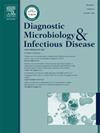Serum VEGF-A and sVEGFR-1 levels as predictors of disease severity in COVID-19 patients
IF 1.8
4区 医学
Q3 INFECTIOUS DISEASES
Diagnostic microbiology and infectious disease
Pub Date : 2025-07-14
DOI:10.1016/j.diagmicrobio.2025.117007
引用次数: 0
Abstract
Background
The pathogenesis of COVID-19 highlights the pivotal role of endothelial dysfunction and dysregulated angiogenic signaling. Vascular endothelial growth factor A (VEGF-A) and its soluble receptor (sVEGFR-1) are critical regulators of vascular integrity. This study aimed to investigate the association between serum VEGF-A and sVEGFR-1 levels and disease severity in patients diagnosed with COVID-19.
Methods
In this single-center observational study, 92 COVID-19 patients, classified into mild, moderate, and severe categories, and 29 healthy controls were enrolled. Serum VEGF-A and sVEGFR-1 levels were quantified using enzyme-linked immunosorbent assay (ELISA). Clinical, demographic, and laboratory data were collected. Statistical analyses included ANOVA, Kruskal-Wallis, Spearman correlation, logistic regression, and ROC curve analysis.
Results
Both VEGF-A and sVEGFR-1 levels were significantly lower in severe COVID-19 patients compared to controls (p < 0.001). Negative correlations were observed between VEGF-A levels and disease severity (r = -0.55, p < 0.001), and between sVEGFR-1 levels and severity (r = -0.48, p < 0.001). Logistic regression analysis identified VEGF-A as an independent predictor of severe COVID-19 (OR = 0.964, p = 0.021). No significant differences in VEGF-A or sVEGFR-1 levels were found between survivors and non-survivors among the severe group.
Conclusion
Serum VEGF-A and sVEGFR-1 levels are inversely associated with COVID-19 disease severity, suggesting their potential role as early prognostic biomarkers. These findings underscore the importance of endothelial dysfunction in COVID-19 progression and encourage further research on angiogenic markers in viral infections.
血清VEGF-A和sVEGFR-1水平作为COVID-19患者疾病严重程度的预测因子
背景COVID-19的发病机制强调了内皮功能障碍和血管生成信号失调的关键作用。血管内皮生长因子A (VEGF-A)及其可溶性受体(sVEGFR-1)是血管完整性的关键调节因子。本研究旨在探讨COVID-19患者血清VEGF-A和sVEGFR-1水平与疾病严重程度的关系。方法采用单中心观察性研究方法,选取轻、中、重度肺炎患者92例,健康对照29例。采用酶联免疫吸附法(ELISA)定量测定血清VEGF-A和sVEGFR-1水平。收集临床、人口统计学和实验室数据。统计分析包括方差分析、Kruskal-Wallis、Spearman相关、logistic回归和ROC曲线分析。结果与对照组相比,重症患者VEGF-A和sVEGFR-1水平均显著降低(p <;0.001)。VEGF-A水平与疾病严重程度呈负相关(r = -0.55, p <;0.001), sVEGFR-1水平与严重程度之间(r = -0.48, p <;0.001)。Logistic回归分析发现VEGF-A是严重COVID-19的独立预测因子(OR = 0.964, p = 0.021)。在严重组中,幸存者和非幸存者之间VEGF-A或sVEGFR-1水平无显著差异。结论血清VEGF-A和sVEGFR-1水平与COVID-19疾病严重程度呈负相关,提示其可能作为早期预后生物标志物。这些发现强调了内皮功能障碍在COVID-19进展中的重要性,并鼓励进一步研究病毒感染中的血管生成标志物。
本文章由计算机程序翻译,如有差异,请以英文原文为准。
求助全文
约1分钟内获得全文
求助全文
来源期刊
CiteScore
5.30
自引率
3.40%
发文量
149
审稿时长
56 days
期刊介绍:
Diagnostic Microbiology and Infectious Disease keeps you informed of the latest developments in clinical microbiology and the diagnosis and treatment of infectious diseases. Packed with rigorously peer-reviewed articles and studies in bacteriology, immunology, immunoserology, infectious diseases, mycology, parasitology, and virology, the journal examines new procedures, unusual cases, controversial issues, and important new literature. Diagnostic Microbiology and Infectious Disease distinguished independent editorial board, consisting of experts from many medical specialties, ensures you extensive and authoritative coverage.

 求助内容:
求助内容: 应助结果提醒方式:
应助结果提醒方式:


